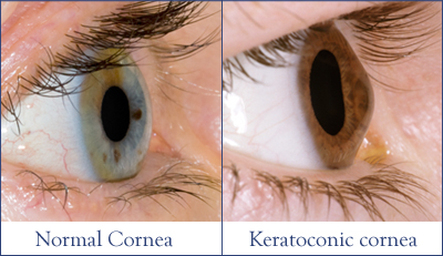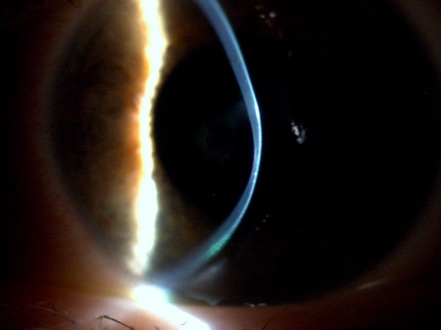What is keratoconus?
Keratoconus is an eye condition affecting the cornea (the front surface) of the eye. It results in an irregular cornea causing distorted (blurred) vision. Generally keratoconus develops in the teenage years but may begin before the age of ten or not until adulthood.
The word keratoconus is derived from latin words, kerato- "cornea" and -conus meaning "cone shaped". This describes the normally round shaped cornea becoming cone-shaped with the progression of the condition. The keratoconic cornea also tends to thin with progression of the condition. Generally keratoconus is a painless condition although it can cause some ocular irritation in more advanced cases.
The severity of keratoconus varies widely between individuals, some may manage with spectacles alone, others may require special contact lenses and a small minority go on to require surgery. Although keratoconus is considered a progressive condition (one that worsens over time) it is common for keratoconus to eventually stabilise (often around the age of 30).
Keratoconus is considered to be a genetic condition, and it is common to find more than one family member (or relative) with the condition. Estimates vary but the prevalence of keratoconus in NZ is approximately 1 in 2000, with 60% of keratoconics being male.
Maori and Pacific Island communities appear to have a slightly higher than average prevalence.
Conditions such as allergy (hayfever), eczema and asthma are common in people with keratoconus. Eye rubbing due to ocular allergy is very common in keratoconus and should be avoided as it can can cause the condition to deteriorate more rapidly. Medications can be prescribed by an eyecare professional to reduce the itching due to ocular allergy.
The word keratoconus is derived from latin words, kerato- "cornea" and -conus meaning "cone shaped". This describes the normally round shaped cornea becoming cone-shaped with the progression of the condition. The keratoconic cornea also tends to thin with progression of the condition. Generally keratoconus is a painless condition although it can cause some ocular irritation in more advanced cases.
The severity of keratoconus varies widely between individuals, some may manage with spectacles alone, others may require special contact lenses and a small minority go on to require surgery. Although keratoconus is considered a progressive condition (one that worsens over time) it is common for keratoconus to eventually stabilise (often around the age of 30).
Keratoconus is considered to be a genetic condition, and it is common to find more than one family member (or relative) with the condition. Estimates vary but the prevalence of keratoconus in NZ is approximately 1 in 2000, with 60% of keratoconics being male.
Maori and Pacific Island communities appear to have a slightly higher than average prevalence.
Conditions such as allergy (hayfever), eczema and asthma are common in people with keratoconus. Eye rubbing due to ocular allergy is very common in keratoconus and should be avoided as it can can cause the condition to deteriorate more rapidly. Medications can be prescribed by an eyecare professional to reduce the itching due to ocular allergy.


